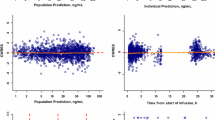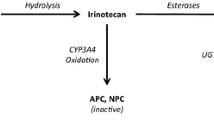Abstract
In a pharmacokinetics study, six patients were treated i.v. with epirubicin (EPI) at the two dose levels of 60 and 120 mg/m2, whereas a further six patients were treated at 75 and 150 mg/m2. Both groups were studied according to a balanced cross-over design; the aim of the study was to assess the pharmacokinetic linearity of epirubicin given at high doses. Both the absolute goodness of fit and the Akaike Information Criterion (AIC) point to a linear, tricompartmental open model as the choice framework for discussing EPI plasma disposition after 16/24 administrations, independent of the delivered dose. After 8 treatments, the minimal AIC value corresponded to a nonlinear tissue-binding model. However, even in these cases, second-order effects were present only during the early minutes following treatment. In a model-independent framework, mean EPI plasma clearance was identical at the two dose levels of 60 and 120 mg/m2 (65.4±8.0 vs 65.3±13.4 l/h,P=0.92). Both the mean residence time (MRT) and the volume of distribution at steady-state (Vss) were similar as well (MRT: 22.6±2.9 vs 24.2±3.7 h;P=0.46; Vss: 21.3±1.5 vs 22.6±6.5 l/kg,P=0.46). No statistically significant difference could be found in mean statistical-moment-theory parameters determined after 75- and 150-mg/m2 EPI doses (plasma clearance, PICI: 83.4±13.5 vs 68.5±12.8 l/h,P=0.12; MRT: 22.6±4.8 vs 21.9±3.9 h,P=0.60; Vss: 26.7±10.5 vs 21.2±7.0 l/kg,P=0.17). Analysis of variance also failed to reveal any significant correlation between dose and plasma clearance. However, when data relative to single patients were examined, a trend toward nonlinear drug distribution as well as a consequent increase in peripheral bioavailability could be observed in 4/6 patients of the 75-mg/m2 vs the 150-mg/m2 group. No significant dose-dependent variation was observed in the ratio between the molecular-weight-corrected areas under the concentration-time curve for the metabolites and those for EPI [60 vs 120 mg/m2: epirubicinol (EPIol), 0.23±0.10 vs 0.22±0.06,P=0.20; epirubicin glucoronide (G1), 0.46±0.14 vs 0.62±0.40,P=0.26; epirubicinol glucuronide (G2), 0.21±0.05 vs 0.30±0.16,P=0.06; and 75 vs 150 mg/m2: EPIol, 0.33±0.22 vs 0.32±0.19,P=0.42; G1, 0.51±0.23 vs 0.46±0.17,P=0.53; G2, 0.18±0.10 vs 0.22±0.10,P=0.34]. In conclusion, all the metabolic pathways seemed well preserved when the dose was doubled, and no evident sign of “saturation kinetics” could be found.
Similar content being viewed by others
References
Akaike H (1974) A new look at the statistical model identification. IEEE Trans Automat Contr 19:716–723
Bevington PR (1970) Data reduction and error analysis for the physical sciences. McGraw-Hill, New York
Camaggi CM, Strocchi E, Tamassia V, Martoni A, Giovannini M, Iafelice G, Canova N, Marraro D, Martini A, Pannuti F (1982) Pharmacokinetic studies of 4′epidoxorubicin in cancer patients with normal and impaired renal functions and with hepatic metastases. Cancer Treat Rep 66:1819–1824
Camaggi CM, Comparsi R, Strocchi E, Testoni F, Pannuti F (1988) HPLC analysis of doxorubicin, epirubicin and fluorescent metabolites in biological fluids. Cancer Chemother Pharmacol 21:216–220
Camaggi CM, Comparsi R, Strocchi E, Testoni F, Angelelli B, Pannuti F (1988) Epirubicin and doxorubicin comparative metabolism and pharmacokinetics. Cancer Chemother Pharmacol 21: 221–228
Camaggi CM, Strocchi E, Carisi P, Martoni A, Tononi A, Guaraldi M, Strolin-Benedetti M, Efthymiopoulos C, Pannuti F (1992) Idarubicin metabolism and pharmacokinetics after intravenous and oral administration in cancer patients: a cross-over study. Cancer Chemother Pharmacol 30:307–316
Cassinelli G, Configliacchi E, Penco S, Rivola G, Arcamone F, Pacciarini A, Ferrari L (1984) Separation, characterization and analysis of epirubicin (4′-epidoxorubicin) and its metabolites from human urine. Drug Metab Dispos 12:4–20
Dixon WJ, Brown MB (1979) BMDP-79 biomedical computer programs. P-series. University of California Press, Berkeley
Draper N, Smith H (1966) Applied regression analysis. J Wiley, New York
Eadie WT, Drijard D, James FE, Ross M, Sadoulet B (1971) Statistical methods in experimental physics. North-Holland, Amsterdam
Eksborg S, Stendahl U, Lönroth U (1986) Comparative pharmacokinetics of Adriamycin and 4′-epi-Adriamycin after their simultaneous intravenous administration. Eur J Clin Pharmacol 30:629
Freedman LS, Workman P (1988) When can the infusion period be safely ignored in the estimation of pharmacokinetic parameters of drugs in humans? Cancer Chemother Pharmacol 22:95–103
Ganzina F (1979) 4′-Epidoxorubicin, a new analogue of doxorubicin: a preliminary overview of preclinical and clinical data. Cancer Treat Rev 10:1–22
Gibaldi G, Perrier D (1982) Pharmacokinetics, 2nd edn. Marcel Dekker, New York
Goodyear MDE (1988) Do doxorubicin and its enantiomer 4′-epidoxorubicin have equivalent activity? A meta-analysis of randomized trials comparing two analogues. Proc Am Assoc Cancer Res 29:192
Jakobsen P, Steiness E, Bastholt L, Dalmark M, Lorenzen A, Petersen D, Gjedde SB, Sandberg E, Rose C, Nielsen OS, Mouridsen HT, Jakobsen A (1991) Multiple-dose pharmacokinetics of epirubicin at four different dose levels: studies in patients with metastatic breast cancer. Cancer Res 28:63–68
James F, Ross M (1983) MINUIT D506. Function minimization and error analysis. CERN Computer Centre Program Library, Geneva
Manaka RC, Schumitzky A, Wolf W (1981) Symbolic programs for structural identification of linear pharmacokinetic systems. Comput Methods Programs Biomed 13:203–213
Moore JW, Pearson RG (1981) Kinetics and mechanism, 3rd edn. John Wiley & Sons, New York
Mross K, Maessen P, Vijgh WJF van der, Gall H, Boven E, Pinedo HN (1988) Pharmacokinetics and metabolism of epidoxorubicin and doxorubicin in humans. J Clin Oncol 6:517–526
Perrier D, Mayersohn M (1982) Noncompartmental determination of the steady-state volume of distribution for any mode of administration. J Pharm Sci 71:372–373
Robert J, Vrignaud P, Nguyen-Ngoc T, Iliadis A, Mauriac L, Hurteloup P (1985) Comparative pharmacokinetics and metabolism of doxorubicin and epirubicin in patients with metastatic breast cancer. Cancer Treat Rep 69:633–640
Tjuljandin SA, Doig RG, Sobol MM, Watson DM, Sheridan WP, Morstyn G, Mihaly G, Green MD (1990) Pharmacokinetics and toxicity of two schedules of high dose epirubicin. Cancer Res 50: 5095–5101
Wagner JG (1979) Fundamentals of clinical pharmacokinetics. Drug Intelligence Publications, Hamilton, Ohio
Weenen H, Lenkelma JP, Penders PGM, McVie JG, Ten Bokkel Huinink WW, De Planque MM, Pinedo HM (1983) Pharmacokinetics of 4′-epi-doxorubicin in man. Invest New Drugs 1:59–64
Yamaoka K, Nakagawa T, Uno T (1978) Application of Akaike's Information Criterion (AIC) in the evaluation of linear pharmacokinetic equations. J Pharmacokinet Biopharm 6:165–175
Young CW (1984) Epirubicin: a therapeutically active doxorubicin analogue with reduced cardiotoxicity. In: Bonadonna G (ed). Advances in anthracycline chemotherapy: epirubicin. Masson Milan, pp 183–188
Young CW (1989) Clinical toxicity of epirubicin. In: Robustelli della Cuna G, Bonadonna G (eds) Update on epirubicin. Advances in clinical oncology, vol 2. Medico-scientifiche, Pavia, pp 29–38
Author information
Authors and Affiliations
Rights and permissions
About this article
Cite this article
Camaggi, C.M., Strocchi, E., Carisi, P. et al. Epirubicin metabolism and pharmacokinetics after conventional- and high-dose intravenous administration: a cross-over study. Cancer Chemother. Pharmacol. 32, 301–309 (1993). https://doi.org/10.1007/BF00686176
Received:
Accepted:
Issue Date:
DOI: https://doi.org/10.1007/BF00686176




